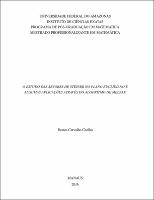| ???jsp.display-item.social.title??? |


|
Please use this identifier to cite or link to this item:
https://tede.ufam.edu.br/handle/tede/5923| ???metadata.dc.type???: | Dissertação |
| Title: | O estudo das árvores de Steiner no Plano Euclidiano e algumas aplicações através do Algoritmo de Melzak |
| ???metadata.dc.creator???: | Coelho, Jhones Carvalho  |
| ???metadata.dc.contributor.advisor1???: | Oliveira, Nilomar Vieira de |
| ???metadata.dc.contributor.referee1???: | Oliveira, Disney Douglas de Lima |
| ???metadata.dc.contributor.referee2???: | Lira, Antonio da Fonseca de |
| ???metadata.dc.description.resumo???: | Dado um conjunto de pontos no plano, que denominamos terminais ou pontos regulares, provase que sempre existe uma árvore mínima que os conecta, chamado "árvore de Steiner". Os terminais podem representar centros de conexão para rotas, elementos de circuito elétrico, ou de redes diversas. Ou seja, o problema em questão é otimizar a comunicação entre os terminais, caso isto seja representado por uma árvore de menor comprimento possível. Nem sempre o "menor comprimento"representa a otimização. O Problema de Steiner possui variações, por exemplo, em que as arestas da árvore só podem seguir direções horizontal e vertical, como no caso de circuitos elétricos. Outra variação é quando cada ponto Steiner tem custo muito alto, e pretende-se obter uma tal árvore com o menor número de tais pontos. Ela será "mínimo local"para comprimento, mas não necessariamente global. Um modelo físico e bastante simples para "árvore de Steiner"é que ela pode ser também realizada por películas de sabão, e por isso compartilham propriedades de Superfícies Mínimas. Como exemplo, considere uma solução de sabão. Ao mergulharmos e retirarmos duas placas paralelas ligadas por pinos, uma película irá conectá-los. Esta representa um grafo de comprimento mínimo que interliga os pinos. Como é sabido, as películas de sabão realizam as Superfícies Mínimas. Para visualizar uma "Árvore de Steiner", recorre-se a Algoritmos Numéricos e Programação Gráfica, os métodos baseiam-se principalmente na implementação dos algoritmos. Este presente trabalho está dividido em três partes: breve história dos problemas de otimização, em destaque o problema de Steiner; teoria sobre a Árvore Mínima ou Árvore de Steiner e o Algoritmo de Melzak; alguns exemplos de casos reais. |
| Abstract: | Given a set of points on the plane, we call terminals or regular points, it proves that there is always a minimum tree that connects called "Steiner tree". The terminals may represent hubs to routes, circuit elements, or different networks. That is, the problem in question is to optimize to communication between terminals, if this is represented by a tree of shortest length possible. Not always the "shorter"is optimization. Steiner problem has variations, for example, the tree can only follow the edges of the horizontal and vertical directions, as in the case of electrical circuits. Another variation is when each Steiner point is very expensive, and it is intended to obtain such a tree with the lowest number of such points. It will be "local minimum"for length, but not necessarily globally. A physical and quite simple model for "Steiner tree"is that it can also be performed by soap films, and therefore share minimum surface properties. As an example, consider a soap solution. Getting closer and withdraw two parallel plates connected by pins, a film will connect them. This represents a minimum length graph that interconnects the pins. As is known, the soap films perform the Minimal Surfaces. To view a "Steiner tree"refers to Numerical Algorithms and Graphical Programming, methods are mainly based on the implementation of the algorithms. This present work is divided into three parts: a brief history of optimization problems, highlighted the Steiner problem; theory of the Minimum Tre or Steiner tree and algorithm Melzak; some examples of real cases. |
| Keywords: | Árvore Mínima Árvore de Steiner Algoritmo de Melzak |
| ???metadata.dc.subject.cnpq???: | CIÊNCIAS EXATAS E DA TERRA: MATEMÁTICA |
| Language: | por |
| ???metadata.dc.publisher.country???: | Brasil |
| Publisher: | Universidade Federal do Amazonas |
| ???metadata.dc.publisher.initials???: | UFAM |
| ???metadata.dc.publisher.department???: | Instituto de Ciências Exatas |
| ???metadata.dc.publisher.program???: | Programa de Pós-graduação em Matemática |
| Citation: | COELHO, Jhones Carvalho. O estudo das árvores de Steiner no Plano Euclidiano e algumas aplicações através do Algoritmo de Melzak. 2016. 60 f. Dissertação (Mestrado em Matemática) - Universidade Federal do Amazonas, Manaus, 2016. |
| ???metadata.dc.rights???: | Acesso Aberto |
| ???metadata.dc.rights.uri???: | http://creativecommons.org/licenses/by-nc-nd/4.0/ |
| URI: | http://tede.ufam.edu.br/handle/tede/5923 |
| Issue Date: | 15-Dec-2016 |
| Appears in Collections: | Mestrado Profissional em Matemática - PROFMAT |
Files in This Item:
| File | Description | Size | Format | |
|---|---|---|---|---|
| Dissertação - Jhones C. Coelho.pdf | 3.42 MB | Adobe PDF |  Download/Open Preview |
This item is licensed under a Creative Commons License





